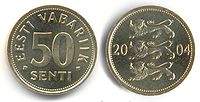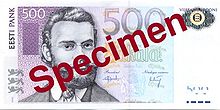- Estonian kroon
-
Estonian kroon Eesti kroon (Estonian) 
Coins ISO 4217 code EEK (num. 233) User(s) None, previously  Estonia
EstoniaInflation 2.8% Source European Central Bank, May 2010 Method HICP ERM Since 28 June 2004 Fixed rate since 31 December 1998 Replaced by €, non cash 1 January 2011 Replaced by €, cash 1 January 2011 € = 15.6466 krooni Band did not fluctuate[1] Subunit 1/100 sent Nickname paper, The family names of the persons on notes: 100 krooni – Koidula, 500 krooni – Jakobson etc., eek Plural krooni sent senti Coins Freq. used 10, 20, 50 senti, 1 kroon Rarely used 5 senti, 5 krooni Banknotes Freq. used 2, 5, 10, 25, 100, 500 krooni Rarely used 1, 50, Central bank Bank of Estonia Website www.bankofestonia.info This infobox shows the latest status before this currency was rendered obsolete. The kroon (sign: kr; code: EEK) was the official currency of Estonia for two periods in history: 1928–1940 and 1992–2011. Between 1 January and 14 January 2011, the kroon circulated together with the euro, after which the euro became the sole legal tender in Estonia.[2][3] The kroon was subdivided into 100 cents (senti; singular sent). The word kroon (Estonian pronunciation: [ˈkroːn], crown) is related to that of the Nordic currencies (such as the Swedish krona and the Danish and Norwegian krone) and derived from the Latin word corona ("crown"). The kroon succeeded the mark in 1928 and was in use until the Soviet invasion in 1940, after which it was replaced by the Soviet ruble. After Estonia regained its independence, the kroon was reintroduced in 1992.
Contents
First kroon, 1928–1940
History
The kroon became the currency of Estonia on 1 January 1928 after having been a unit of account since 1924. [4] It replaced the mark at a rate of 100 mark = 1 kroon. The kroon was subdivided into 100 senti.
In 1924, the kroon was pegged to the Swedish krona at par, with a gold standard of 2480 kroon = 1 kilogram of pure gold. The standard received real coverage with the reserves backing the kroon. The issue of treasury notes and exchange notes was terminated. In order to secure the credibility of the kroon, Eesti Pank exchanged kroon for foreign currency. All these measures restored confidence in the domestic banking and monetary sector, contributing to the economic reinvigoration of the country and to the improvement of the reputation of the Estonian state in the international arena.
During the Great Depression in 1933, the kroon went off the gold standard, devaluated 35% and obtained a currency peg with the Great Britain Pound (GBP) at 1 GBP = 18.35 kroon.[5] The Estonian kroon kept this peg and circulated until the Soviet invasion of 1940. The kroon was exchanged for the Soviet ruble at a rate of 1 ruble = 0.8 kroon.
Banknotes and coins
In 1928, the first coins of this currency were issued, nickel-bronze 25 senti pieces. These were followed by bronze 1 sent in 1929, silver 2 krooni in 1930, bronze 5 senti and nickel-bronze 10 senti in 1931, silver 1 kroon in 1933, bronze 2 senti and aluminium-bronze 1 kroon in 1934, nickel-bronze 20 senti in 1935, nickel-bronze 50 senti in 1936.
On 25 July 1940, 4 days after founding of Estonian SSR, the last Estonian pre-WW II coin, new 1 sent (date 1939) was issued.
In 1927, before the kroon was officially introduced, 100 marka banknotes circulated with an "ÜKS KROON" (1 kroon) overprint. Eesti Pank introduced 10 krooni notes in 1928, followed by 5 and 50 krooni in 1929, 20 krooni in 1932 and 100 krooni in 1935.
Second kroon, 1992–2010
History
The kroon was reintroduced as Estonia's currency on 20 June 1992, replacing the Soviet ruble at a rate of 1 kroon = 10 rubles. (Each person was able to change maximally 1500 rubles to 150 kroons.) Initially, the Estonian kroon was pegged to the Deutsche Mark at a rate of 8 krooni = 1 Deutsche Mark.[6] After the introduction of the euro the fixed exchange rate of 1.95583 DEM to EUR led to an exchange rate of 15.64664 krooni to the euro. On 27 June 2004, as Estonia joined the ERM II-system, the central parity of the Estonian kroon was revalued (by less than 0.001%) to 15.6466 krooni per euro.[7] On 1 January 2011 the euro replaced the kroon as the official currency of Estonia. The kroon circulated alongside the euro until 15 January 2011 at which point it ceased to be legal tender.[8] However, the Eesti Pank will exchange banknotes and coins of kroon and sent without amount and time limit into the Euro.
Banknotes
In 1992, banknotes were introduced in denominations of 1, 2, 5, 10, 25, 100 and 500 krooni. Some of the 5, 10, 25, 100 and 500 krooni notes were dated 1991. In 1994, a 50 krooni note was introduced. Unlike others, the 1 kroon and 50 kroon notes were issued only once.
Notes in circulation before being replaced by the euro:
- 1 kroon (1992),
- 2 krooni (1992, 2006, 2007),
- 5 krooni (1991, 1992, 1994),
- 10 krooni (1991, 1992, 1994, 2006, 2007),
- 25 krooni (1991, 1992, 2002, 2007),
- 50 krooni (1994),
- 100 krooni (1991, 1992, 1994, 1999, 2007),
- 500 krooni (1991, 1994, 1996, 2000, 2007).
Current Series Image Value (EEK) Value (€) Main Colour Description Obverse Reverse Obverse Reverse 

1 kroon €0.06 Orange/Brown Kristjan Raud Toompea Castle 

2 krooni €0.13 Grayish blue Karl Ernst von Baer University of Tartu 

5 krooni €0.32 Orange Paul Keres Narva castle & Ivangorod fortress 

10 krooni €0.64 Red Jakob Hurt Tamme-Lauri oak tree 

25 krooni €1.60 Green Anton Hansen Tammsaare Vargamäe village 

50 krooni €3.20 Dark green Rudolf Tobias Estonia Theatre 

100 krooni €6.39 Light blue Lydia Koidula Baltic Klint 

500 krooni €31.96 Purple Carl Robert Jakobson Barn swallow Coins
50 senti 2004 
Reverse Obverse In 1992, coins were introduced (some dated 1991) in denominations of 5, 10, 20 & 50 senti, as well as 1 kroon. The 1 kroon was struck in cupronickel, the others in aluminum-bronze. However, in 1997, nickel-plated steel 20 senti were introduced, followed by aluminum-bronze 1 kroon in 1998. 5 senti coins were not issued after 1994 but were still legal tender. The cupronickel 1 kroon coins from 1992, 1993 & 1995 stopped being legal tender on 31 May 1998.[9] The 5 krooni coins were commemorative pieces and were rarely seen in circulation.
Coins in circulation before being replaced by the euro:[10]
- 5 senti (1991, 1992, 1995)
- 10 senti (1991, 1992, 1994, 1996, 1997, 1998, 2002, 2006, 2008)
- 20 senti (1992, 1996, 1997, 1999, 2003, 2004, 2006, 2008)
- 50 senti (1992, 2004, 2006, 2007)
- 1 kroon (1992, 1993, 1995, 1998, 2000, 2001, 2003, 2006, 2008)
- 5 krooni (1993, 1994).
Current exchange rates
Current EEK exchange rates From Google Finance: AUD CAD CHF EUR GBP HKD JPY USD RUB From Yahoo! Finance: AUD CAD CHF EUR GBP HKD JPY USD RUB From OzForex: AUD CAD CHF EUR GBP HKD JPY USD RUB From XE.com: AUD CAD CHF EUR GBP HKD JPY USD RUB From OANDA.com: AUD CAD CHF EUR GBP HKD JPY USD RUB See also
References
- ^ General principles of the Estonian monetary system, Bank of Estonia
- ^ "Stages of the cash changeover". European Central Bank. http://www.ecb.int/euro/changeover/estonia/html/index.en.html. Retrieved 2010-05-12.
- ^ Ministers offer Estonia entry to eurozone January 1 France24, 8 june 2010
- ^ "Estonian Coinage". European Commission. http://www.worldnotaphily.com/Coinage_Estonia.php. Retrieved 2010-05-13.
- ^ Bank of Estonia. "Some facts from the history of Eesti Pank and Estonian finance". http://www.bankofestonia.info/pub/en/yldine/pank/ajalugu/Ajalugu/kronoloogia.html. Retrieved 13 May 2010.
- ^ Bank of Estonia. "History – Eesti Pank 1919–1992". http://www.bankofestonia.info/pub/en/yldine/pank/ajalugu/Ajalugu/ajalugu.html?objId=306762. Retrieved 2006-12-30.
- ^ "Estonian kroon included in the Exchange Rate Mechanism II (ERM II)" (Press release). ECB. 27 June 2004. http://www.ecb.int/press/pr/date/2004/html/pr040627_2.en.html. Retrieved 2009-11-04.
- ^ Stages of the cash changeover ECB: Estonia (2011)
- ^ Coins in circulation Bank of Estonia
- ^ "Estonian coins". Bank of Estonia. http://www.bankofestonia.info/pub/en/yldine/pangatahed/mynt/. Retrieved 2009-11-04.
- Krause, Chester L. and Clifford Mishler (1991). Standard Catalog of World Coins: 1801–1991 (18th ed. ed.). Krause Publications. ISBN 0873411501.
- Pick, Albert (1994). Standard Catalog of World Paper Money: General Issues. Colin R. Bruce II and Neil Shafer (editors) (7th ed.). Krause Publications. ISBN 0-87341-207-9.
External links
Preceded by:
Estonian mark
Reason: independence
Ratio: at parCurrency of Estonian kroon
1928 – 1940Succeeded by:
Soviet ruble
Reason: Estonian SSR
Ratio: ?Preceded by:
Soviet ruble
Reason: Estonian SSR
Ratio: at parCurrency of Estonian kroon
1992 – 2010Succeeded by:
Euro
Reason: entry into Eurozone
Ratio: 1 EUR = 15.6466 EEKEstonian currency and coinage Topics Euro Former Estonian Coins 5s · 10s · 20s · 50s · 1 EEK · 5 EEKFormer Estonian banknotes Currencies named Crowns or similar Circulating Obsolete Proposed As a denomination Cent derivatives Topics on the euro General Administration European Central Bank · ECB President · European System of Central Banks · Eurosystem · Ecofin · Euro Group · Euro summitFiscal provisions Stability and Growth Pact · European Financial Stability Facility · European Financial Stabilisation Mechanism · European Stability Mechanism · Euro Plus PactHistory "Snake in the tunnel" · European Monetary System (I: ECU · II: ERM · III: EMU) · European Monetary Cooperation Fund · European Monetary Institute · Enlargement · Black WednesdayEconomy Denominations 1c · 2c · 5c · 10c · 20c · 50c · €1 · €2 · €2 commemorative coins · Other commemorative coins · Identifying marks · Starter kits · Europa coin programme€5 · €10 · €20 · €50 · €100 · €200 · €500Coins by
countryEUNon-EUAdoption by
other countriesEUBulgaria · Czech Republic · Denmark · Latvia · Lithuania · Hungary · Poland · Romania · Sweden · United KingdomNon-EUYielded
currenciesEuropean Currency Unit · Austrian schilling · Belgian franc · Cypriot pound · Dutch guilder · Estonian kroon · Finnish markka · French franc · German mark · Greek drachma · Irish pound · Italian lira · Luxembourgish franc · Maltese lira · Monegasque franc · Portuguese escudo · Sammarinese lira · Slovak koruna · Slovenian tolar · Spanish peseta · Vatican liraRemaining
currenciesERM IIother (EU)British pound (incl. Gibraltar pound) · Bulgarian lev · Czech koruna · Hungarian forint · Polish złoty · Romanian leu · Swedish kronaCurrencies of post-Soviet states in circulation Abkhazian apsar (unrecognized) · Armenian dram · Azerbaijani manat · Belarusian ruble · Euro (Estonia) · Georgian lari · Kazakhstani tenge · Kyrgyzstani som · Latvian lats · Lithuanian litas · Moldovan leu · Nagorno-Karabakh dram (unrecognized) · Russian ruble (Russia and Abkhazia (unrecognized) and South Ossetia (unrecognized)) · Tajikistani somoni · Transnistrian ruble (unrecognized) · Turkmenistan manat · Ukrainian hryvnia · Uzbekistani somobsolete Chechen naxar (unrecognized) · Estonian kroon · Georgian kupon lari · Latvian rublis · Lithuanian talonas · Moldovan cupon · Soviet ruble · Tajikistani ruble · Ukrainian karbovanetsCategories:- Crown
- Cent
- Currencies of Europe
- Currencies replaced by the euro
- Economy of Estonia
- Modern obsolete currencies
Wikimedia Foundation. 2010.








